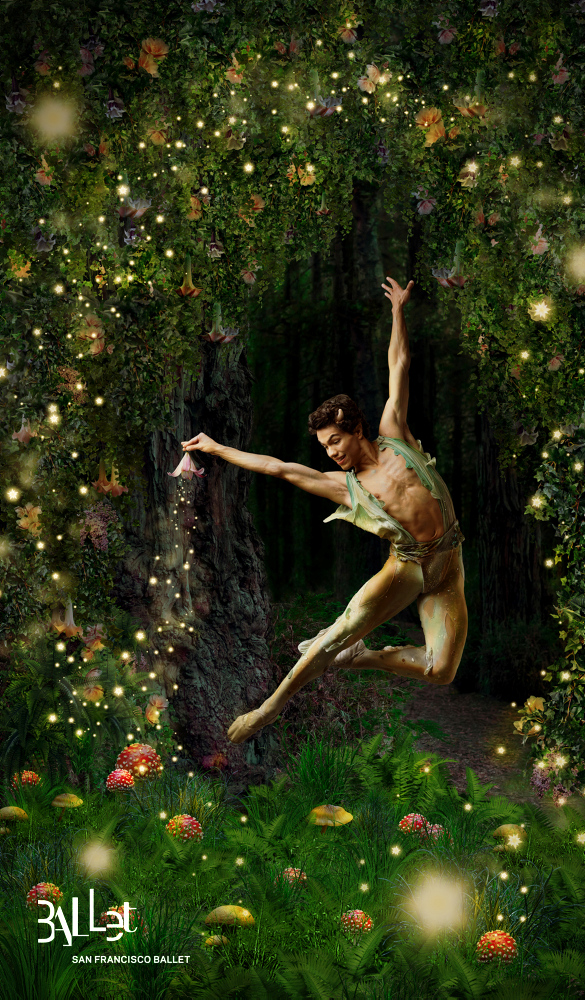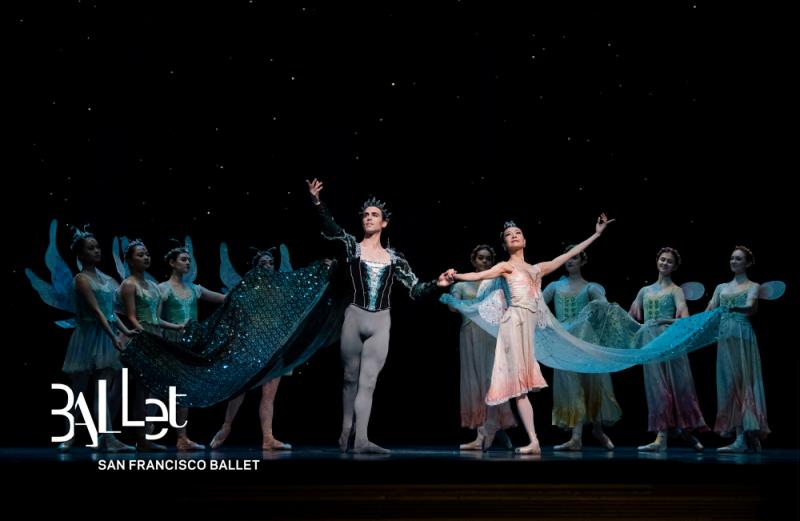Review: A MIDSUMMER NIGHT'S DREAM at San Francisco Ballet Delivers Triumphantly on a Balanchine Classic

in San Francisco Ballet's "A Midsummer Night's Dream"
Opening night of San Francisco Ballet's triumphant production of George Balanchine's "A Midsummer Night's Dream" was both a thrilling and heartbreaking occasion. Thrilling because SFB gave a masterful performance of this Balanchine classic that has gone missing from its repertoire for far too long. Heartbreaking because mere moments after the final curtain came down, a notice was issued that all subsequent performances of "Midsummer's" scheduled run had been cancelled due the Mayor's efforts to prevent the spread of the corona virus. Of course, health concerns must take precedence, but it was still incredibly sad to think that others would not be able to experience this glorious production, at least for the time being. I also couldn't help feeling for the dancers and artistic staff who had clearly poured their hearts and souls into this huge endeavor. As for me, I had already made plans to return at least twice more to catch the ballet with different casts and see what new colors each brought to it. For now, that will all just have to wait. In the meantime, let's not let current events dim the glowing memories of opening night.
As soon as the orchestra struck up the sublime overture, it was clear we were in good hands. The Mendelson music is big, lush and juicy and the SF Ballet Orchestra plays it beautifully. There was already enchantment in the air, and that's before we'd seen even a single step of George Balanchine's choreography. Created for New York City Ballet in 1962, "Midsummer" is a rare story ballet from the 20th-century master, in fact the first full-length narrative he created in America. As Balanchine is famously known for abstract works, I was especially curious to see how he would adapt the Shakespeare play with its labyrinthine plot. Turns out he borrowed a page from the structure of "The Nutcracker," wherein the bulk of the plot is dispatched within the first act, with the second act largely given over to pure dance, in this case to celebrate the triple weddings that end the Shakespeare play. Balanchine is in a playful, mathy, Rockettes-ian mood throughout that neatly matches the frolicsome spirit of the original play.
As the curtain rises, dozens of bugs played by young SFB students are flitting about a nighttime forest. Balanchine's choreography here is delightful and surprisingly substantive for dancers of such a tender age. Most impressively, he pulls off the neat trick of devising movement that is genuinely cute without being cutesy. Soon mischief-maker Puck leaps onto stage to begin the storytelling, which is somewhat trimmed down from the Shakespeare play. Oberon and Titania, King and Queen of the Fairies, quarrel over her young page. Oberon orders his servant Puck to cast spells first on Titania and then on a wandering quartet of lovers which causes anyone coming under its influence to fall in love with the first person the eyes behold. This leads to much comic misunderstanding and re-partnering before the Duke and Queen of Athens discover them asleep in the forest, aid them in resolving their differences, and proclaim a triple wedding for themselves and the two couples.

with corps de ballet members in the background
The physical production, acquired from Pacific Northwest Ballet, is often enchantingly lovely, if also a little off-the-mark here and there. Martin Pakledinaz' opening drop of an enormous spider against a glittering, gossamer filigree of a variety of flora perfectly establishes an air of summery enchantment. The succeeding forest sets consisting of arched arbors laden with all manner of outsized flora and occasional fauna are attractive enough if also feeling a little weighty and fusty overall. Pakledinaz' first-act costumes for Titania and the kids are delightful, magical and diaphanous. On the other hand, the tutus for the women in the second act feel too rigid and heavy for such a light-spirited celebration.
The dancing on opening night was fabulous throughout, as if the dancers had been waiting all year just for the opportunity to tackle this Balanchine chestnut and bring it to life. Virtually everyone onstage seemed particularly engaged and in-the-moment, right down to the smallest children, relishing in the opportunities to provide off-beat, comic moments, without neglecting the need to execute the movement beautifully. Among the more prominently featured roles, Esteban Hernandez brought a wonderful off-kilter attack to the character of Puck, that was, well, the very definition of puckish. Darting here and there, changing speeds at unpredictable moments, Hernandez perfectly set the capricious tone for the ballet. Yuan Yuan Tan made a lovely, ethereal Titania, especially in an exquisitely-danced Act I pas de deux with Tiit Helimets as her cavalier. Joseph Walsh made a spirited Oberon, tackling the notoriously difficult, leaping solo originally choreographed on Edward Villella and dispatching it with panache and skill. Doris André, Benjamin Freemantle, Mathilde Froustey and Ulrik Birkkjaer were a breezy delight as the four star-crossed lovers. Repétiteur Sandra Jenning's sure hand was evident throughout as the dancers let the movement itself do all the comic work, never larding on extra schtick or mugging to drive the jokes home.
A big Act II pas de deux is, like much of the ballet, unusually constructed. Danced by an anonymous couple, it largely consists of an extended lyrical and tender adagio without the kind of fireworks that would typically end a second-act showpiece. Happily, it is perhaps most beautiful adagio I've seen outside of "Swan Lake", and was dreamily danced by Misa Kuranaga and Angelo Greco, with grace and legato line for days. Once the celebrations have ended and we've been treated to a stage full of ebullient dancers in a kaleidoscope of ever-changing formations, the ballet concludes much as it began, with a swarm of fireflies buzzing about and Puck floating back to the heavens against a twinkling, indigo backdrop. In a word, magical.

flanked by Mathilde Froustey & Ulrik Birkkjaer as Helena & Demetrius (L)
and Benjamin Freemantle & Doris André as Lysander & Hermia (R)
with members of the corps de ballet in the background
I am occasionally asked to recommend a ballet that would be a good bet for all kinds of audiences. I honestly can't think of a better choice than "Midsummer," regardless of your prior exposure to ballet. Its classic plot and ample comedy make it easily accessible to ballet neophytes, while its complex, inventive choreography provide enough substance to engage seasoned balletomanes. Plus, hard core SFB fans get the added pleasure of seeing the dancers delve into new roles and show different aspects of their considerable talents. You also get a lot for your entertainment dollar - a huge company of magnificent dancers augmented by dozens of talented little ones, a large orchestra including a women's choir, enchanting stage magic and an overall spirit of goodwill.
Surely, SFB will bring "A Midsummer Night's Dream" back before long. When it does return, don't miss it!
(Photos by Erik Tomasson)
San Francisco Ballet's "A Midsummer Night's Dream" suspended performances after its March 6, 2020 opening night at the War Memorial Opera House, 301 Van Ness Avenue, San Francisco, CA. Running time was 2:05, including a 20-minute intermission. For information on future performances, visit www.sfballet.org or call (415) 865-2000 M-F 10am-4pm.
Comments
.png)
|
.png)
|
Videos

